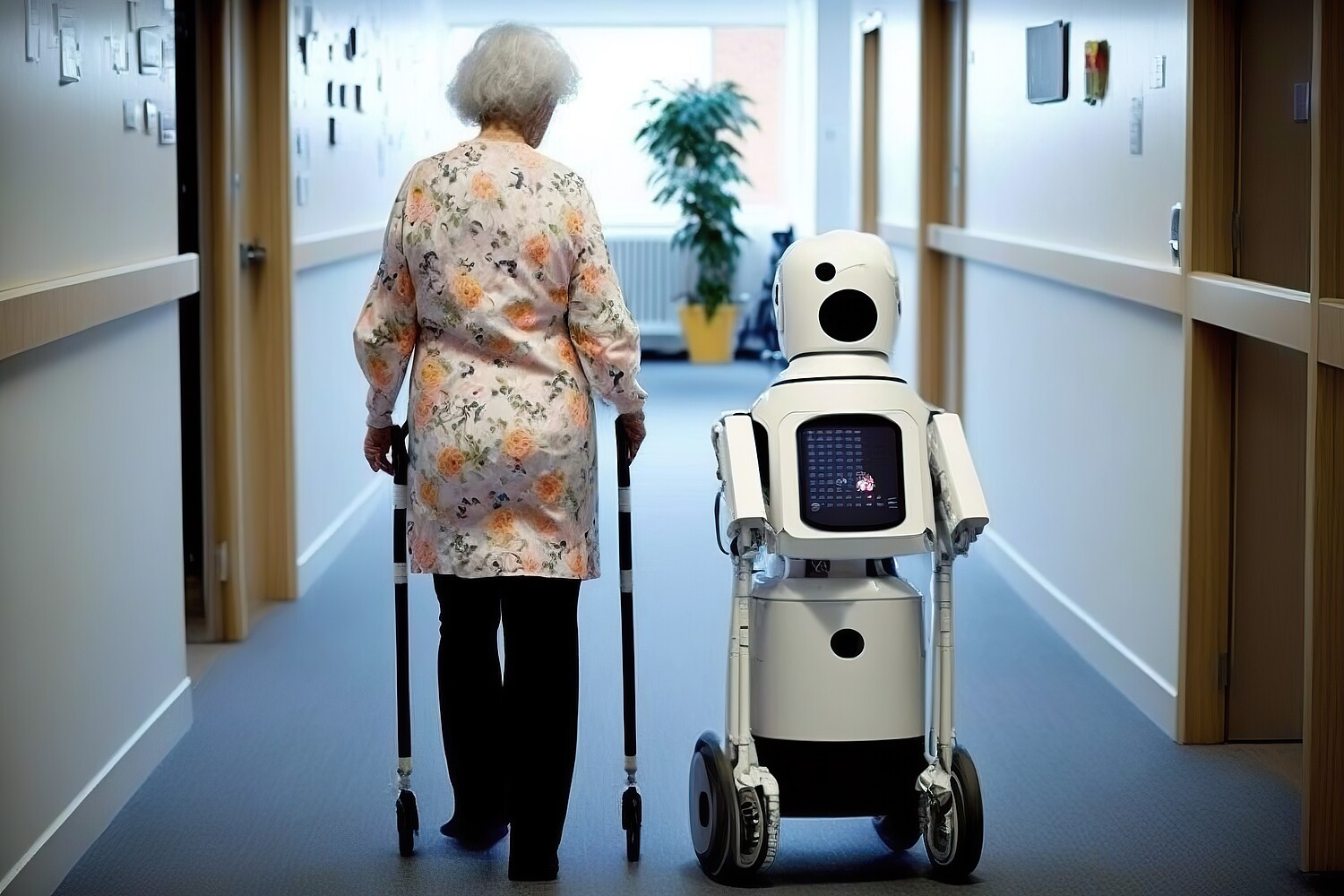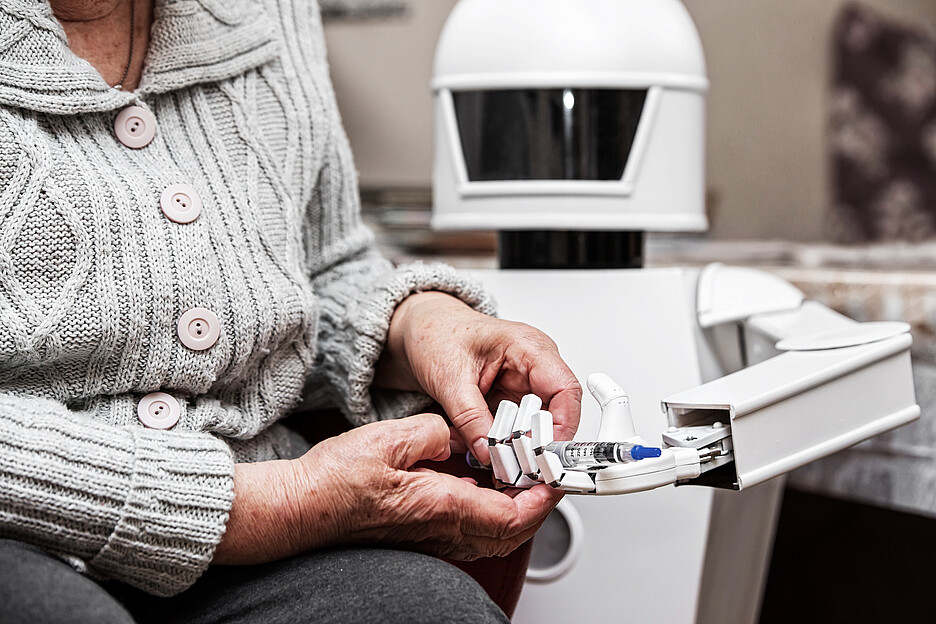
Digitisation in the nursing sector: People or robots – do we have a choice?
Nursing professionals can certainly imagine the use of robots in their workplace – at least within certain limits. A ZHAW study also shows care recipients to be surprisingly open-minded as regards the use of new technologies.
Paro was a trailblazer when he first hit the scene. He is a cute little guy who in fact doesn’t come across as robotic at all. If you tickle his neck, he looks up and whimpers, while his fur almost invites you to stroke him. The robotic baby seal, which was developed in Japan, was initially used in the area of geriatrics as a means of calming people with dementia. For a number of years now, Paro has also been used in the field of child psychiatry. He has touch and light sensors, is able to recognise language and has the ability to learn names. The cuddly seal is considered to have been one of the first “social robots” to interact with humans. In the meantime, other more powerful machines have become available. One such example is Nao, a French product who assumes a human-like form. There is also Lio, a mobile assistance robot who was specifically developed in Zurich to perform work in nursing and care facilities with his special gripper arm.
Dehumanisation or a weight off nurses’ shoulders?
The use of robots in the nursing sector is a controversial topic. Against the backdrop of a shortage of nursing staff, the potential use of robots has raised hopes of relieving the strain placed on staff who are permanently working at the limits of what can be considered reasonable. At the same time, however, ethical concerns are mounting. There is a growing fear that the provision of machine-based care to people requiring assistance may become the standard, leading to a process of dehumanisation taking hold in hospitals, retirement homes and nursing facilities.
Despite the potentially explosive situation we are confronted with, research in this area is very thin on the ground, says Iris Kramer from the ZHAW Institute of Nursing. “There are still very few meaningful studies that address the impact of interaction with social robots on nursing staff and patients.” Working in a team of five, Kramer therefore took it upon herself to evaluate the possibilities for using such robots as well as the risks and opportunities they pose from the perspective of potential user groups as part of the study “Social robots in the Swiss healthcare system.” The results provided an in-depth analysis based on the findings yielded by the interdisciplinary paper “Social robots, empathy and emotions”, which also investigated the use of robots in public spaces, private households and the education sector.

“In reality, the robots are not yet as advanced as those we see in science fiction films.”
The team led by Iris Kramer focussed their study on those directly affected within the healthcare sector. A total of 15 women and 11 men aged between 33 and 93 dedicated half a day to debating social robots in the interest of research. The group included care recipients, i.e. residents of retirement and nursing homes, as well as a representative from a patient advocacy group. Representatives from relevant professions in the inpatient and outpatient healthcare sector were also in attendance. They included nurses, a doctor, healthcare facility management staff, individuals involved in the provision of therapy , IT specialists and a representative from social services.
Entertainers, waiters, memory trainers
To kick things off, various robots showed the 26 participants the current state of the art. Nao played music, danced and, just like a physiotherapist, demonstrated head, arm and leg movements for those present to copy. Next up was the mobile assistance robot Lio. He fetched a drinking cup, which he grasped with great precision, before leading a memory exercise. Pepper in turn started a conversation with the participants. And finally, video clips showed other robots at work. These, of course, included Paro, the baby seal.
The reactions varied greatly, reports Iris Kramer. “Some people thought it was great to chat with Pepper.” However, one nursing home resident was scared of the robots. Others, adds Kramer, were disappointed by the limited capabilities of the robots. “In reality, the robots are not yet as advanced as those we see in science fiction films,” says Kramer with a smile on her face. Nao, for example, was unable to get the people from the home excited about his movement exercises. Was this perhaps because his programmers had chosen the wrong songs? Music requests were of no help in any case, as Nao only understands pre-programmed phrases. Nevertheless, Iris Kramer is convinced that such shortcomings will soon be improved: “With the current boom in artificial intelligence, technological developments are likely to advance at a rapid pace.”

“The machine sounds the alarm if somebody falls while going to the toilet at night. This could relieve the burden placed on relatives.”
Following the demonstrations, those in attendance split into focus groups and discussed the opportunities and risks posed by such robots and their possible applications. The findings garnered were further expanded on with an online follow-up survey. From an employee perspective, the results suggest there are numerous tasks for which robots might be suitable. Working as personal assistants, robots could fetch nursing materials, prepare medication, empty drainage tubes, clean dentures, help during patient relocations, heat up food that has been set aside or remind people of appointments. They could also conceivably be used to provide motivation during physiotherapy, offer support during cognitive training or take on monitoring functions such as bedside vigils.
A substitute for a lack of human closeness
Among those requiring care themselves, the ability of robots to fetch and bring things, be it magazines, food or drinks, was also at the very top of their list of potential uses. Assistance with personal hygiene and changing clothes, for example help with putting on socks, was also frequently mentioned, as were technological matters, such as support with making phone calls. Some home residents would certainly use robots to help fill the gap left by their lack of human closeness: to accompany them during their daily lives when they feel lonely, to play games, to keep them company, to chat, to interpret or to give them a sense of security when they go for a walk. Their potential use as sex robots was also mentioned.

Helping people achieve greater autonomy
In other words, social robots should ideally help people in becoming more autonomous – including individuals living at home who are reliant on support. For example, such robots could remind people to drink or take their medication. They could also sound the alarm if somebody falls while going to the toilet at night. “This could also relieve the burden placed on relatives,” says Iris Kramer.
Where some saw opportunities, others warned of risks. For instance, some pointed to possible invasions of privacy owing to image and sound recordings as well as the processing of other data. Safety concerns were also voiced. Is there any guarantee that a robot will not mistakenly bring a sugary drink to a diabetic patient? Who would be liable for such an error? Scepticism was also expressed with respect to how greatly the new technology might ease the strain on nursing staff if they are to be saddled with the new task of monitoring and maintaining the robots and scheduling their use. One of the greatest dangers is said to be the potential loss of emotional proximity should people be cared for exclusively by machines according to a mechanical schedule.
The study concluded that it is therefore important that the tasks to be performed by a social robot are specifically defined prior to its deployment and that the right to human care must be guaranteed: “Affected individuals should always be able to choose whether they wish to be cared for and supported by a robot or a human.”
0 Comments
Be the First to Comment!